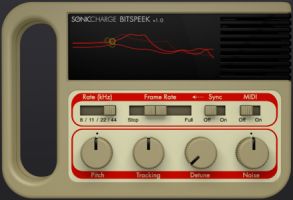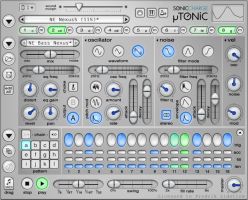
Sonic Charge has released version 3.0 of MicroTonic, the first major upgrade to MicroTonic in over five years. Sporting over 20 new features and a brand new look, MicroTonic is as good as new again. The upgrade is free for all registered users and it is 100% backwards compatible with earlier versions of MicroTonic (Except if you are running on a Mac PPC G4, as PPC G5 is the minimum requirement for 3.0). For new customers it costs $99 (+VAT).
Sonic Charge has also launched a new product called Bitspeek. It's an effect plug-in. It costs $29. It will make you sound like a robot. It's available for Windows and Mac OS X (Intel) in VST and AU effect plug-in formats.
Sonic Charge MicroTonic v3.0
Major New Features:
- A morph slider allows you to interpolate all eight drum patches simultaneously between two end-points. You can edit the drum patches with the morph slider at any position and it will adjust the interpolation end-points accordingly. Morph is an automatable and MIDI controllable parameter, so it can be used both as a performance parameter as well as an editing feature.
- Matrix editor window for viewing and editing the pattern steps of all eight drum channels simultaneously. (Bonus feature: you can drag channel labels to reorder the drum channels of the preset.).
- MIDI Program Change message support for instantaneously switching between up to 16 different presets (loaded into memory). (It is also possible to switch programs with MIDI notes.).
- Drag and drop patterns as MIDI files directly into your sequencer (supported by all major hosts).
- "Edit All Channels" button enables adjusting parameters for all drum channels simultaneously. E.g. turn up the distortion on all channels. µTonic will write parameter automation for all affected channels, so the effect can be automated.
- A new "choke group" feature lets you assign two or more channels that should play mutually exclusively and cut each other off. Useful for closed and open hi-hats for example.
- A preset name display sits in the top of the window, with previous and next preset buttons and a popup list when you click the display.
- Support for MIDI Pitch Wheel for real-time pitch transposition with a range of up to 2 octaves.
- A new "Stop Voices with MIDI Note Off" option makes it possible to sustain the sound while you hold down MIDI keys (if you use µTonic as a synth). It is also useful for changing the length of drum sounds with note lengths in your sequencer.
- Alternative "pattern launch modes": "Switch Next" (the behavior in earlier versions of µTonic), "Switch Directly", "Retrigger" and "Retrigger Gated".
- Undo / redo.
- Shift-click menu buttons to quickly repeat last selected menu item.
- New 3D-rendered skin. Sharper, brighter, sexier with 32-bit graphics. (Yes, µTonic version 2.0 was using 20th century 16-bit RGB graphics still).
Other Improvements:
- New menu functions: "Transpose" (all channels or a single drum patch). "Alter Drum Patches" (all channels or a single drum patch). "Randomize Accents and Fills" (on entire pattern or single channel). "Revert to Saved" (revert to last saved version of preset).
- New trial system: up to three weeks of trial with full functionality. After that µTonic will go silent until you register. Weeks will only be counted when you actually use µTonic.
- µTonic will now reload the most recently used program bank (of 16 programs) automatically when you create a new instance. (This behavior can be changed from the Preference Dialog.).
- From the file browser you can now select to load only the patches or the patterns from a preset.
- All filter algorithms have been replaced with a new custom design based on a modified state-variable topology. It allows exact replication of the original filter response, but with better accuracy, speed and stability when the frequencies are modulated.
- Parameter smoothing improved to allow quicker unfiltered parameter changes as well as slower filtered changes.
- You can optionally remap MIDI Controller Change values so that you can reach zero exactly on bipolar parameters. Also, with this option turned on, MIDI CC on the three frequency parameters will be quantized to whole semitones.
- µTonic can execute simple script files (written in PikaScript) from a popup menu. A script button will show in the top-left corner if µTonic finds script-files in a designated scripts folder.
- A write protect switch can protect the programs in memory by reverting any edits as soon as you switch to another program.
- You can assign the same MIDI key or controller number to several different functions. Useful for layering several channels on a single MIDI key or controlling many parameters from the same knob.
- All existing presets (including those in our additional downloadable patch packages) have been modified to obtain a high degree of consistency concerning which drum channels plays what type of sound. E.g. channel 1 plays bass drum patches, channel 5 plays snare drum patches etc. Also, all presets have been volume normalized using an automatic RMS algorithm.
Minor Changes:
- µTonic 3.0 uses a new registration key system. Registration keys for version 3.0 are not compatible with previous versions of µTonic.
- All file formats have been upgraded (using a cleaner and more consistent text format). µTonic version 3.0 files are not downwards compatible with µTonic version 2.0, so new file extensions have been chosen: ".mtpreset" and ".mtdrum".
- Noise levels are much more consistent across different sample rates (the levels at 44.1khz were used as reference).
- New WAV export code allows for 24-bit audio export and improved WAV-file compatibility.
- Improved timing accuracy of notes and parameter changes, especially when host is using odd (or just very large) buffer sizes. This is at the expense of a constant latency of 64 samples, but all major hosts should support latency compensation.
- The envelopes are slightly improved. E.g., they now go all the way down to level 0 exactly (avoiding clicks if µTonic is run through extreme compression).
- Changes to "Mod Amount" will affect the sound immediately. (Previously, changes to this parameter didn't have effect until the next note on.).
- Step buttons light up when notes are played (Yeah, this is the minor changes section.).
Bug / Compatibility Fixes:
- Fixed bug with VST MIDI events outside the current processing block.
- Fixed minor bug in linear noise envelope decay.
- Automation now starts directly when you click a fader (instead of waiting until it is dragged).
- Improved problem with µTonic spontaneously losing registration.
- Fixed a problem where holes(.) would appear in the user-interface on Mac.
- Fixed a problem with the oscilloscope when using the multiple outputs version (in certain hosts).
- Works (better) with host and bridges (e.g. VST Bridge) that runs different instances in different threads.
- Many, many other minor fixes.
Sonic Charge Bitspeek v1.0
 Bitspeek is a real-time pitch-excited linear prediction codec effect. Right now you are probably thinking, "oh, another one of those"? Or perhaps not. Chances are that you have never heard about "linear prediction", although most of us use it daily when we talk on our cell phones. Linear prediction coding is a voice compression technology that appeared in commercial products in the seventies and was implemented in some well-known speaking toys of the early eighties.
Bitspeek is a real-time pitch-excited linear prediction codec effect. Right now you are probably thinking, "oh, another one of those"? Or perhaps not. Chances are that you have never heard about "linear prediction", although most of us use it daily when we talk on our cell phones. Linear prediction coding is a voice compression technology that appeared in commercial products in the seventies and was implemented in some well-known speaking toys of the early eighties.
Sonic Charge applied this technology to create a VST / AU effect plug-in that analyzes audio, extracts a number of parameters (including pitch, volume and formant data) and then resynthesizes the audio using a simple oscillator, noise and filter architecture.
A number of playback parameters that adjusts the pitch and tonal quality of the sound as well as support for MIDI and a beat-synchronized "formant freezing effect" have been added. Despite having only a few simple controls, this box can produce a broad range of sounds from cheap speaking toys to high-end vocoder and talkbox effects.




 Other Related News
Other Related News









